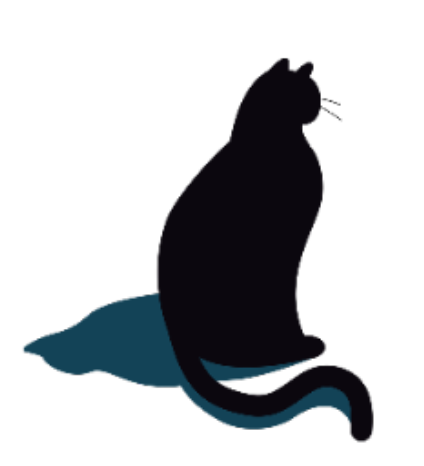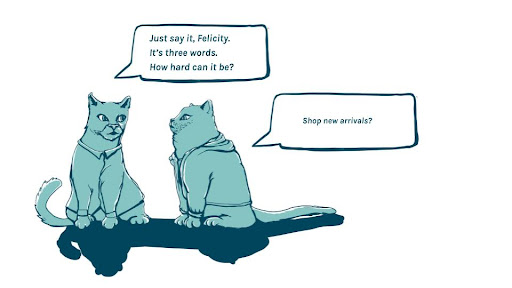Written by Margaret Kaplan
April 3rd, 2022
Anatomy of an Email

The Anatomy of Email: A Full-Frontal Guide
You’ve seen her around these parts before. A bit sweet, a bit provocative. At times she’s clever and light, others she’s serious. Sometimes she leaves actual hearts in your eyes. Sometimes it feels like she’s reading your mind.
She’s the perfect girl email—so bedeviling, so charming, so entrancing, so disarming. You don’t even care that she’s playing by a certain handbook, that she says the same thing to everyone. She always beckons you closer. She leaves you hanging on her every word.
Want her? No, no. Outta here with that, Spike Jonze! She’s an email and that would be weird. Still, you’d like to learn a few things from her, maybe pick up a few tricks. And good news, you can. You just need to get to know her form.
To help you out, we’re baring all—everything we know about crafting an effective email.
Yeah, we’re talking body. And subject line. And CTA, too.
The Subject Line: Burlesque or, the Art of the Tease
You have important things to say—a message to get across. You don’t want your email to live and die between a sneaker sale and a fracking petition.
But what’s an inbox if not the world’s most competitive field, cluttered with promises, promo codes, and half-off pizzas?
If it feels like you’re shouting into the void, it’s probably because you are. We, the general we, are famously fickle, distractible, shallow.
According to the stats, nearly half of us decide whether we’re going to open an email based on the subject line alone. So if you want to draw our eyes and clicks, you’ll need to grab our attention with the perfect opening line.
To do so, you'll have to seduce, inveigle. You’ll need to put on a show, do a little dance, or try your hand at a bit of burlesque.
Take my clothes off? Not literally. Or literally. Just probably not while you write the emails.
Let me back track.
While burlesque (like any performance art worth its salt, IMO) involves the artistic removal of clothing, it isn’t about nudity. Burlesque is about the stretch of time—the thick, tense, ecstatic stretch—between the idea of nudity and the fulfillment of nudity.
Less strip. More tease.
Successful email subject lines leave us intrigued—wanting more. What makes a subject line alluring, irresistible even, is exactly what makes a burlesque performance tick:
- Tension
- Promise
- Tease
Your subject line should reveal just enough to spark interest and float the relevance of your content, leaving the rest to the imagination. It should:
- Show just enough – Aim for a word count of 6 to 10 words, the subject line length that draws the highest open rates.
- Be coy – But be clear. You have a small opening window (the next act comes to the stage in 30 seconds, and wow, she’s something), so make your subject line count. Clue your audience into what they can expect from opening your email—a discount code, latest products, or a message from a founder—even if you don’t reveal all of your cards at once.
- Play with props – Subject lines with a little visual flair tend to perform well when it comes to open rates. Emphasis on a little. Spiff up your subject line with one (just one!) emoji, and enjoy higher unique open rates.
- Make your audience feel seen – Wink. Nod. Gesture. Assume a direct tone and look them in the eye. Don’t be afraid to get personal or to speak to the unique impulses and pain points that drive your target customers. But avoid overfamiliarity. Assume your audience is here for the show, not to feel fully on display.
Preheaders: Please Welcome to the Stage Your Supporting Characters
Hot in here? Let’s cool down, shall we, and discuss the humble preheader—slightly less flashy and certainly less bold than the subject line, but valuable nonetheless.
The plucky best friend! The evergreen bridesmaid! The adroit passenger who takes the steering wheel when the driver falls asleep or is but a mere string of incoherent emojis.
Summarizing the content of the email, the pre-header exists to support the subject line and supplement its reach with relevant information:
- What’s inside the email
- What’s at stake by opening the email
- What the reader can expect from double-clicking
Though most preheaders tend to clock in at roughly one sentence long (or 35 to 100 characters) the ideal length of your preheader will likely depend on the length of your subject line, given the limited real estate on most mobile apps and web browsers.
Short, suggestive subject? That generally means you have some wiggle room to clarify with a longer preheader.
Longer, expository opening line? Be aware that your readers may not be able to enjoy the entirety of your preheading copy.
If you want to get every word front and center in every inbox—and you should, given the fact that the subject and preheader may be the only message that some subscribers or recipients receive—aim to contain the juiciest bits of your preheader copy within that mobile-friendly inner limit of 35 characters.
A Personal Detour: The Subject Lines that Have Wooed Me as of Late
Now, back to baring it all.
In the spirit of Write What You Know™and Show Don’t Tell™ here are some actual real-life subject lines from real-life emails that I’ve opened within the last 72 hours:
- A life-changing baking formula
(butter AND sugar ?!?!)
- Looking for a late-night snack?
(you know me!!!!!)
- 20% off all this newness ✨
(say more)
- Put potato chips in your salad
(say that)
- We miss you
(dad?)
- Time’s running out
(I am haunted by this knowledge every day.)
Here’s why they worked on me, a real person with an inbox that currently clocks in at 1041 unread messages.
- [#1] These subject lines teased me with information that’s relevant to my interests: eating, feeling valued, saving money on new things, the unyielding passage of time.
- [#2] These subject lines made me feel something (even if that feeling was sometimes…not great) because they were, for the most part, pointed, personal—directed at me. Note the strategic use of questions, imperative tone, and the out and out emotional manipulation.
- [#3] These subject lines were short and spiffy—never exceeding six words. They gave me just a tiny, tempting glimpse (and once, a tiny sparkle).
In short, these subject lines hit every note of a skilled burlesque performance. There was tension, there was promise, and oh boy, there was tease.
Body Work: Take It All Off (Text Blocks, Jargon, Irrelevant Content)
Alright, you did it. You nailed the opening line. We can’t get enough. All eyes on you, baby. The spotlight is hot! The attention…it’s almost too much. (Ha ha not really.)
So what are you going to do with your one wild and precious email? You are going to play it cool. You are going to play it cool!
Here’s why. You are worthy. You are confident. Your value is intrinsic, implicit. (Just look at that sexy promo code.) You don’t need to wear that stupid hat. Take off that stupid hat! Peacocking is a figment of a distant, weary past, my friend. Don’t. Make. This. Weird.
Ways that you can make it weird:
- Doing too much. Your copy has more jargon than a B-school happy hour. Your adverbs have adverbs. You are squeezing every penny out of that MFA, and yes, your subscribers have noticed.
- Getting aggressive. Funny isn’t it? How some people move so gently through this world, and then have no problem hitting their dear email recipients right in the face with a brick wall of text. Don’t do this. Provide ample breathing room. White space. A moment of zen. Avail yourself of bullets and one liners to craft sweet, sweet skimmable copy.
- Wasting everyone’s time. Most of us struggle to make it all the way through the emails that we need to read, let alone the emails that we want to. Keep your copy concise and to the point. Cut away any instances of unnecessary, irrelevant information.
So what should you do? A lot. With a little.
For most intents and purposes, you have about 150 words—max—to work with. Not very many, granted, but enough to strike up a meaningful conversation and make a lasting impression. By clearing out jargon, text walls, and irrelevant information, you’re reclaiming space.
Now you’re free to weave in narrative, address pain points, and invite engagement with active, motivating language. Be free! Flourish!
The CTA: When All the Rest Is Stripped Away

In life, so much comes down to those three little words.
I miss you.
I love you.
Shop Sale Now.
Introducing the CTA: the call to action. Your email should always contain a clear CTA, a short directive that guides your recipient to your intended outcome that might sound something like:
- Redeem Your Reward
- Get Free Shipping
- Register Now
- Start Your Trial
Effective CTAs inspire readers to make the ultimate decision—clicking through to your website, subscribing to your services, or launching into your sales pipeline.
Your CTA should be concise, active, and impossible to miss, because it’s competing with a lot of outside noise and interference. They don’t need to press this button. They know that, in fact, they probably should not press this button. They have newsletters to read! Slacks to answer!
How will you get them to press this button?
Try this: a good old-fashioned mix of brutal honesty and emotional warfare. Consider exactly where you would like them to go, what you would like them to do, and why it’s important that they follow your directive. Then, consult with your grandmother or roommate on how to best leverage psychological tactics including:
- Guilt
- Fomo
- Exclusivity
- Urgency
Like this. Need help crafting effective CTAs? Request a complimentary email sequence from Copycat today and join other industry leaders. Hurry. Everybody’s doing it. Don’t miss out.
Copycat Copywriters: Crafting Purr-fect Emails, Tip to Tail
There you have it: the anatomy of the perfect email. She’s mysterious, magical, and multi-faceted, and though we’ve taken a close look at what makes her tick, we’ve barely scratched the surface.
From unique broadcast campaigns to automated welcome sequences, shopping cart reminders, and super-casual-but-super-effective follow ups, we can help you develop targeted emails that your subscribers will open—and adore.
Tempted? Try us out.
Sources:
Marketing Charts. Brand and Subject Lines Fuel Email Opens; Clutter Drives Users Away. https://www.marketingcharts.com/demographics-and-audiences/youth-and-gen-x-21629
Invespcro. Email Subject Lines – Statistics and Trends. https://www.invespcro.com/blog/email-subject-lines-statistics-and-trends/
Campaign Monitor. The Key to Email Subject Lines That Get Opened: 8 Data-Backed Ways To Boost Open Rates. https://www.campaignmonitor.com/blog/email-marketing/7-data-backed-ways-to-write-email-subject-lines-that-boost-open-rates/